Analyst Mick McGuane on the strategy and tactics that will decide 2020 preliminary finals
How do each of the four preliminary final teams gain an edge — and how can they be stopped? Expert analyst Mick McGuane dissects the tactics and strategy that will decide who makes the Grand Final.

AFL
Don't miss out on the headlines from AFL. Followed categories will be added to My News.
The four teams left in a remarkable 2020 AFL season have proven themselves a class above the rest of the competition.
But only two can make it though to the Grand Final. Expert analyst Mick McGuane takes a close look at the strategy and tactics that will decide next weekend’s two preliminary finals.
PORT ADELAIDE V RICHMOND
First preliminary final, Adelaide Oval, Friday, 7.50pm
HOW THEY PLAY
The Power are a high-volume disposal team (averaging the fourth-most disposals in the AFL) and a strong contest/stoppage side. They play with a “get it forward” mentality to maximise their front-half game. They are the AFL’s best territory team (+9.4 Inside-50 differential). This allows them to cover all exits so the opposition struggles to transition the ball from defence to the forward line. They create on average 23 forward-half intercepts per game and scoring from those intercepts is a real strength.
The Tigers play a chaos game with a surge mentality, wanting to keep the ball in motion at all costs. That invites a high-pressure contest. Pressure and tacking are features of their game. They are a strong forward-half team and play to a strong 18-man defensive-based system to generate turnovers in that area of the ground. They have a great capacity to score off the back of those turnoverst.
RELATED: THE MOST PUZZLING ASPECT OF TIGERS’ SEMI WIN
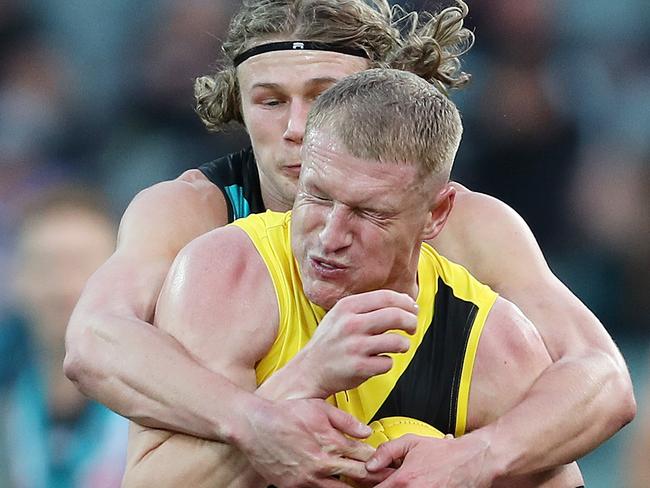
PORT ADELAIDE
THE THEME
Pressure and effective tackles are critical to their success. Their mantra must be to stick their tackles – BALL and ALL. Port needs to bring the heat. Frontal pressure is their key. The Tigers love to play the game at speed and go forward with the ball. As soon as opposition teams retreat, it opens up more space for the Richmond ball carrier to run into and more time to assess the next option. Port’s highest tackle count this year is 76. That number must be replicated on Friday night.
THE CHALLENGE
Port Adelaide’s 18-man defensive structure must be aggressive. In 2020, they have been a very strong forward-half team, ranking second for time in forward half (+5:46 minutes). This creates an opportunity for Richmond to win the ball back and transition from D50 to F50.
Port’s vulnerability against the best teams comes from their points conceded from defensive half chains. They conceded 57 to Geelong in Round 12, 36 to Brisbane in Round 5, and 34 against Richmond in Round 11. Against every other team, they have conceded only 16.7. How well Port manages to stifle and disrupt Richmond’s ball movement out of D50 will be pivotal to the result.
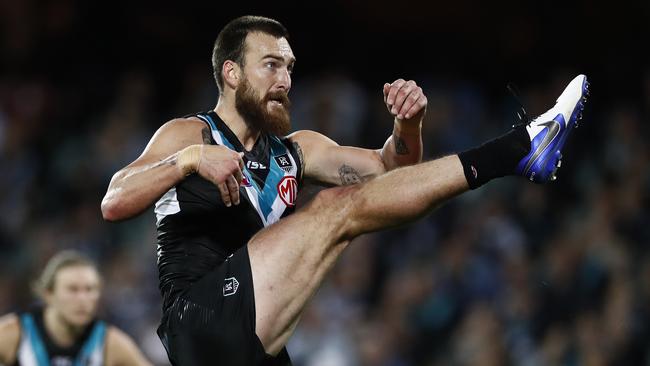
MORE PORT ADELAIDE NEWS:
Why Power, Lions are vulnerable: Malthouse
Powell-Pepper: I’ve made peace with my past
How Ollie Wines rewrote 2020 script
Kane Cornes: How Port can gain mental edge
THE KEY
Keeping Port’s forwards connected to Richmond’s defenders is a must. Ken Hinkley cannot allow Richmond to set up behind the ball with an outnumber, either out of stoppages or in general play. So players like Zak Butters, Connor Rozee, and Brad Ebert cannot get too high up the ground. If they do, and get in and among the numbers, defenders like Nick Vlastuin, Dylan Grimes, Noah Balta and Bachar Houli will drop off their respective opponents, guard space and set up for intercept opportunities. Equalising the numbers will provide strong contested situations and help take away Richmond’s marking strength in this part of the ground which thwarts their greatest strength- their turnover game.
RICHMOND
THE THEME
Richmond must neutralise – and defend – stoppages. Port is a terrific stoppage team with the ruck combination of Scott Lycett and Peter Ladhams, and we know Ollie Wines, Travis Boak, Sam Powell-Pepper, Tom Rockliff and Robbie Gray relish the tough stuff in tight.
The Tigers’high scoring from centre bounces and around the ground stoppages against St Kilda was an anomaly compared to how they generally score. The Tigers kicked 4.2 from centre bounces compared to St Kilda’s zero score. And kicking 8.4 to 1.3 from stoppages overall secured the Tigers a preliminary final berth. They found a way to win differently against the Saints (no Paddy Ryder helped their cause). Don’t expect the same luxury against the Power!
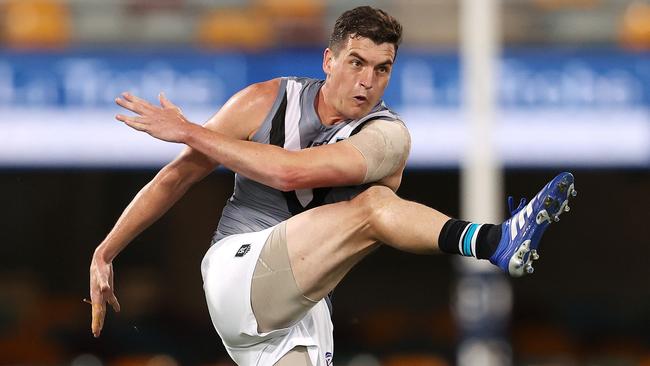
THE CHALLENGE
Don’t be too Charlie Dixon conscious! David Astbury didn’t play in Round 11 when Dixon was a tower of strength, taking three forward-50 contested marks and kicking 2.4. Astbury should be assigned the task of diluting Dixon’s influence. The Tigers like to defend deep, getting numbers back, often 30m from the goal line, which allows little pockets of space 40-50m out to become available, so the likes of Brad Ebert, Connor Rozee or even a drifting midfielder into that area can be used. This is something the Tigers must be aware of at all times. If their minds are too obsessed with Dixon, these other opportunities could hurt them.
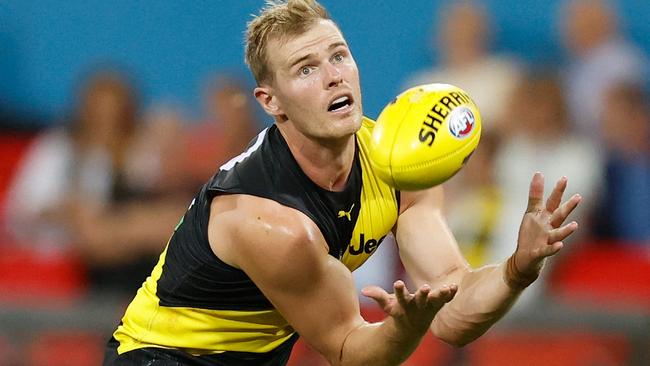
THE KEY
Don’t get scored against on turnover. Richmond has been outscored on turnover on four occasions this year. Against the Saints, Richmond was beaten in the turnover battle and its own game was being tested as the Tigers were kept to their second-lowest turnover tally of 3.4 (22) for the year. Victory came from stoppage dominance. To win this way, is it a positive or negative?
Port Adelaide kicked 10.9 (69) to 8.3 (51) from turnovers the last time these teams met, Richmond’s worst turnover differential (-18 points) for the season. I’m not too concerned with that return as the Tigers resembled a VFL team that day. Inclusions like Trent Cotchin, Astbury, Bachar Houli, Dion Prestia, Shane Edwards and Toby Nankervis will make them better for longer. They found another way against the Saints, but it must be highlighted on the other three occasions they have lost points from turnover – Port Adelaide (-18) in Round 11, St Kilda (-10) in Round 4 and Hawthorn (-9) in Round 3, they lost the game.
THE MAGNET BOARD
IF I WERE PORT ADELAIDE …
Let’s call it Operation Dusty. He doesn’t venture into the defensive 50. His disposals and heat map proves that. Of his 371 disposals this season, only four have come in D50. His damage is done centre/forward, albeit not as damaging as his past three years. Tom Jonas is the preferred match-up when Martin plays deep forward. When he is on the ball – at stoppages and in general play – the combination of Ollie Wines and Travis Boak must have the responsibility of working on and off him to expose his poor defensive capabilities.
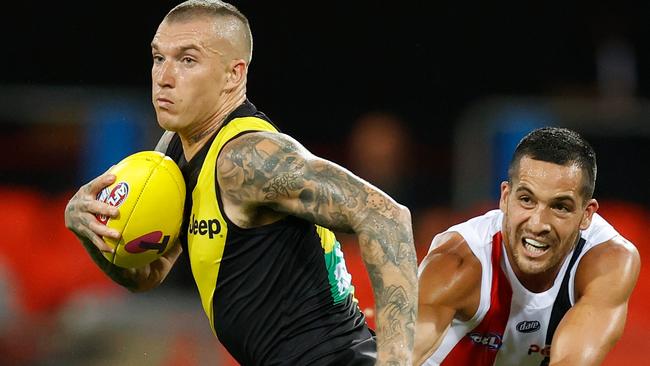
MORE RICHMOND NEWS:
Why Tom Lynch will be free to play in the preliminary final against Port Adelaide
Marlion Pickett two wins from playing in second AFL premiership in 20 games
As a Plan B, Port should introduce a goalkeeper at the back of their press if Richmond is getting through and over too easily to score. The other suggestion would be using midfielder Tom Rockliff to cover corridor/wing space when Richmond looks to transition out of its defence. He is smart enough to set up good defensive field position. Eliminating corridor/wing exits will force Richmond to kick down the line, something that Brisbane did brilliantly in the qualifying final.
IF I WERE RICHMOND …
Dimma, resist the temptation of rucking with Astbury. Leave him for Dixon! Allow Noah Balta and Dylan Grimes to give defensive support. I’d consider bringing in Mabior Chol as relief ruck and to use him as another aerial threat to challenge the undersized Port defenders. Nankervis must push back hard into D50 to offer up support against Dixon. Nank has great courage and is marking the ball well. I would be conscious of Hamish Hartlett and Dan Houston’s positioning as intercept defenders. Keep them honest and accountable when the ball is going forward. Getting them into contested situations is important.
MICK’S TIP: Richmond by 12 points
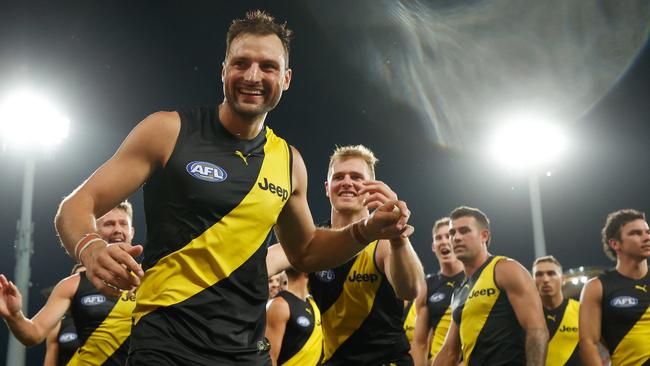
BRISBANE LIONS V GEELONG
Second preliminary final, Gabba, Saturday, 7.40pm
HOW THEY PLAY
Brisbane’s game revolves around contest, pressure and territory. The Lions are a low-disposal, go-forward-with-the-ball team. They have the highest kick-to-handball ratio in the competition and are aggressive with their ball movement. They take the game on and are prepared to take risks, using the corridor the second-most of any side when exiting D50. They are a team that comes in behind their attack to ensure they lock the ball in their F50 to ensure they play a strong forward-half game.
Geelong is a strong contested team, an aspect of their game that they don’t get enough recognition for. They are tough. The Cats are methodical with their ball use, as they love to control the tempo of the game through kick-mark style, as we witnessed on Saturday night. The Cats took an astonishing 134 marks with 120 of those being uncontested. They have great balance in defence and attack, being ranked second defensively and ranked No.1 for attack.
BRISBANE
THE THEME
‘Play Our Way’. That has to be at the forefront of their minds. Their game style holds up. Getting the ball inside F50 and creating opportunities to score is a priority. The only way you can achieve that is to win the contest and be a good clearance team. Once in there, the potential threats of Charlie Cameron (29.22 this year) and Eric Hipwood (23.18) will cause problems, and they have support from Cam Rayner (16.7), Lincoln McCarthy (15.15) and Zac Bailey (13.10) who can hit the scoreboard.
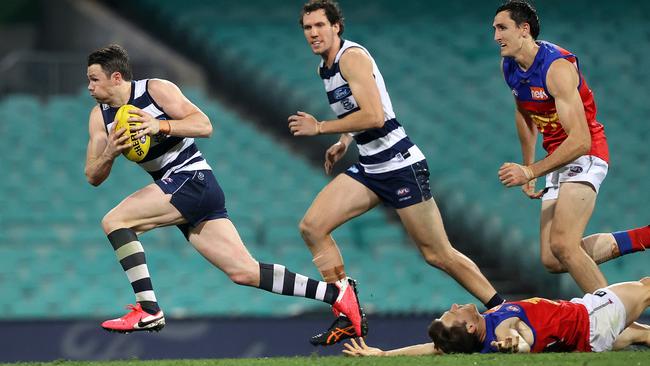
THE CHALLENGE
Hunt the ball, that’s got to be their catchcry. That will lead to contested possession wins. The reason I say this is that the Lions have been ranked 14th in contested possession differential since Round 6. They have won the contested possession count in only three of their past 13 games. The challenge is there to turn that around against the Cats. Finals are all about winning critical contested situations and the Lions need to do that in the air (with Hipwood up front and Harris Andrews down back) and on the ground with Lachie Neale, Dayne Zorko, Charlie Cameron, Brandon Starcevich and others. It doesn’t matter what area of the ground it is, when it is your turn to go, you must go. It will be the difference between playing in a Grand Final or not. Winning the 50-50s will be game-defining.
THE KEY
Their start must be ruthless and execution with their conversion must stand up. Both teams have won 11 first quarters this year, albeit Geelong has played one extra game. Given the Lions lack the experience of their counterparts, they need a good start and must convert their opportunities. Both are important from a psychological standpoint. Brisbane’s shot-at-goal accuracy sits at 42.7 per cent, ranked 17th in the AFL, although they have made improvements in the past month. In comparison, Geelong is ranked second at 52.2 per cent. Finishing their work up forward will be crucial to the Lions, as they will get ample opportunities based on their strong territory game.

GEELONG
THE THEME
‘Control the ball’. The Cats need to force the Lions to defend. It tests their concentration and challenges the Lions defensive structures to stay in sync, something they had to address mid-season. They must also challenge Brisbane’s ability to intercept the ball when the team transitions from D50 to F50. To do that, you must execute the decisions you make by keeping possession of the ball, something the Cats have historically been very good at doing. They are a highly efficient team on the back of this ball use. They can have fewer inside-50s, yet still generate a high number of shots at goal and still hit the scoreboard so effectively.
THE CHALLENGE
Geelong must control the potential threats. Neale won’t replicate the zero first-term disposals from the qualifying final. He must be kept in check around clearance or contested situations because of his ability to win the ball and his creative ball use. He brings others into the game. The threat of Hipwood is real, and the Cats have to decide if it is Henderson or Harry Taylor as his opponent.
Is their speed a concern? We witnessed against the Tigers how Hipwood wanted to get high up the ground and be a part of the connection out of defence. The half-backs — Daniel Rich and Grant Birchall — must not be allowed time with the ball. The Cats need Sam Simpson, Gary Ablett or Gryan Miers to apply enormous pressure on them as they so often set the Lions up with their attacking and precision ball use.
THE KEY
Geelong must win the midfield battle. In their Round 6 clash, the Cats were 22 points down in the second quarter before Joel Selwood and Patrick Dangerfield got them going through the middle, off the back of losing Quinton Narkle and Duncan to injury in the first quarter. On Saturday night, Dangerfield spent 86 per cent of his time in attack and only 14 per cent in the midfield. Part of that was to do with the fact that the Cats were hardly challenged by the Magpies, which meant Danger could stay forward and preserve his energy. He will spend a lot more time in the middle here alongside Selwood, Duncan, Brandan Parfit, and Mark Blicavs and Menegola on the outside. The ability to score from stoppages will be interesting — the Cats are ranked No.1 and the Lions No.3.
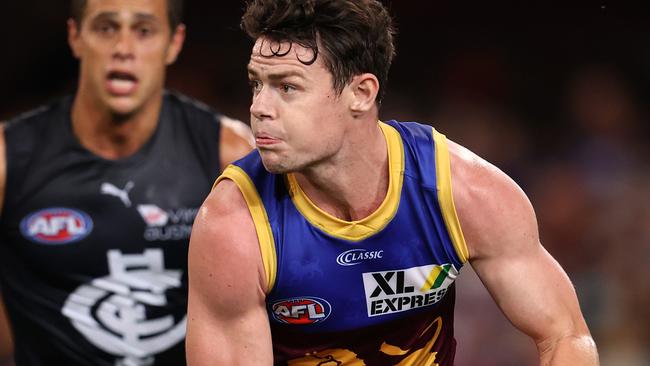
THE MAGNET BOARD
IF I WAS BRISBANE ...
Harris Andrews is a no-brainer to play on Tom Hawkins. Chris Fagan has to have a plan to limit the influence of Mitch Duncan. He can’t be allowed to dominate the way he did against Collingwood — 30 disposals (19 in the first half), 487 metres gained and 12 marks (all uncontested). Mitch Robinson has to play on Sam Menegola’s wing and the Lions also have to reference Tom Stewart and Lachie Henderson when the Cats win possession down back. Stewart and Henderson took 25 uncontested marks between them against Collingwood. They use the ball well, which helps the Cats with their controlled style and ball security. McCarthy, Cameron, Zorko and Rayner must reference them.
IF I WAS GEELONG
Mark O’Connor must play on Charlie Cameron and aim to dilute his influence. Cameron can light up the crowd and the game. Rhys Stanley must continue to keep sliding forward after his centre bounce ruckwork, allowing Blicavs to be the mobile ruckman. That becomes even more important when Dangerfield is forward as this will challenge the Lions defenders to think and act quickly to get their preferred match-ups. It creates confusion for the Lions and presents the Cats with a potential tactical advantage. Cam Guthrie is the man to counter Lachie Neale. Guthrie doesn’t really tag any more, but he needs to be conscious of Neale. He cannot allow the Brownlow Medal favourite to get off the chain. At stoppages he needs to sit on his hip and own the outside. Also, Chris Scott wouldn’t want to underestimate Jarrod Lyons either, as he is in good form and his influence around stoppages shouldn’t be underestimated.
MICK’S TIPS: Geelong by 9 points
MORE AFL NEWS:
Moneyball: Braydon Preuss wants to be a Giant, Orazio Fantasia to leave Essendon
Brownlow Predictor: See the leaderboard, every vote for every game and club winners
Originally published as Analyst Mick McGuane on the strategy and tactics that will decide 2020 preliminary finals
